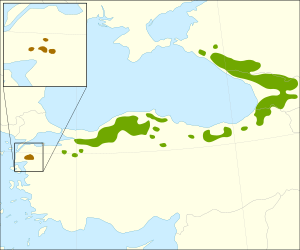Nordmann fir facts for kids
Quick facts for kids Nordmann fir |
|
|---|---|
 |
|
| Nordmann firs in Dombay, Karachay-Cherkessia, Caucasus | |
| Conservation status | |
| Scientific classification | |
| Genus: |
Abies
|
| Species: |
nordmanniana
|
 |
|
| Natural range of A. nordmanniana. Distribution of subspecies A. n. nordmanniana and A. n. bornmuelleriana is in green, and that of A. n. equi-trojani is in brown. | |
The Nordmann fir (also called Caucasian fir) is a type of fir tree. It grows naturally in the mountains near the Black Sea. You can find it in countries like Turkey, Georgia, and the Russian Caucasus. These trees like to grow high up, usually between 900 and 2,200 meters (about 3,000 to 7,200 feet) above sea level. They need places with a lot of rain, more than 1,000 mm (about 40 inches) each year.
Scientists believe the Nordmann fir spread from areas that stayed green during the last Ice Age. These areas were along the eastern and southern coasts of the Black Sea. Even today, you won't find this tree far from the Black Sea coast, even if the climate seems right.
Contents
What the Nordmann Fir Looks Like
The Nordmann fir is a very large evergreen coniferous tree. Evergreen means it keeps its green leaves all year round. It can grow very tall, reaching 55 to 61 meters (about 180 to 200 feet). Its trunk can be as wide as 2 meters (over 6 feet) across. Some Nordmann firs in the Western Caucasus Reserve have been reported to be even taller. They can reach 78 meters (256 feet) or even 85 meters (279 feet) tall. This makes them some of the tallest trees in the Caucasus region and even in Europe.
The leaves of the Nordmann fir are like flat needles. They are about 1.8 to 3.5 cm (0.7 to 1.4 inches) long. They are shiny dark green on top. On the underside, they have two blue-white stripes. These stripes are made of tiny pores called stomata, which help the tree breathe. The tip of each needle is usually blunt or slightly notched. But on young trees, especially on fast-growing shoots, the tips can be pointed.
The tree also produces cones. These cones are 10 to 20 cm (4 to 8 inches) long and 4 to 5 cm (1.6 to 2 inches) wide. Each cone has about 150 to 200 scales. Under each scale, there are two winged seeds. When the cones are ripe, they break apart to release their seeds.
How the Nordmann Fir Got Its Name
The Nordmann fir was named by a scientist named Christian von Steven. He named it after his friend, Alexander von Nordmann (1803–1866). Alexander von Nordmann was a Finnish zoologist who directed the Odessa Botanical Gardens.
Different Types of Nordmann Fir
There are two main types, or subspecies, of the Nordmann fir. They are slightly different and grow in different areas. They mix together where their growing areas meet in northern Turkey.
- Caucasian fir (Abies nordmanniana subsp. nordmanniana): This type grows in the Caucasus mountains. It also grows in the eastern Pontic Mountains in northeastern Turkey. Its new shoots often have fine hairs.
- Turkish fir (Abies nordmanniana subsp. equi-trojani ): This type grows in northwestern Turkey. This includes the western Pontic Mountains and other mountains southeast of the Sea of Marmara. Sometimes, scientists consider this a completely separate species. In Turkey, it is seen as a distinct species called Abies equi-trojani. This type of fir is found in only one small area on Kaz Dağı (Mount Ida) in northwestern Turkey. Because it grows in such a small area, it is considered "Endangered." Its new shoots are usually smooth and hairless.
Uses of the Nordmann Fir
The Nordmann fir is a very popular tree for many reasons.
Christmas Trees
It is one of the most important types of trees grown for Christmas trees. People love it because its needles are not sharp. Also, the needles stay on the tree for a long time, even after the tree dries out. This makes it a great choice for holiday decorations.
Garden and Park Tree
The Nordmann fir is also a popular tree for planting in parks and large gardens. It looks very nice and adds beauty to these spaces. A special type of Nordmann fir called 'Golden Spreader' has even won an award from the Royal Horticultural Society.
Other Uses
In Europe, this tree has been planted to help regrow forests. This is done to prepare for possible changes in forests due to climate change. The wood of the Nordmann fir is soft and white. It is used for general building projects and for making paper.
Gallery
See also
 In Spanish: Abeto del Cáucaso para niños
In Spanish: Abeto del Cáucaso para niños





